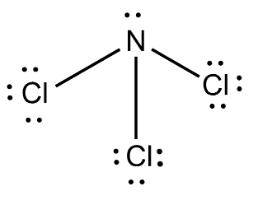Answer
396.9k+ views
Hint:We know that hydrolysis means ‘reaction with water’, so hydrolysis of nitrogen trichloride means the reaction of nitrogen trichloride with water. Nitrogen trichloride has a molecular formula $NC{l_3}$ . It is a nonpolar covalent compound.
Complete answer:We know that Nitrogen trichloride has a molecular formula $NC{l_3}$ . It is also called trichloramine. Nitrogen trichloride is obtained when ammonium salts like ammonium nitrate react with chlorine. We can write the structure of $NC{l_3}$ as

Here nitrogen and chlorine form three covalent bonds. $N$ has an atomic number $7$ and it has an electronic configuration $1{s^2}2{s^2}2{p^3}$ , we can see that $p - $ orbital is half-filled. Chlorine has an atomic number $17$ . The electronic configuration of chlorine can be written as $1{s^2}2{s^2}2{p^6}3{s^2}3{p^5}$ .
Now according to our question, the assertion is $NC{l_3}$ undergoes hydrolysis. This means we have to react $NC{l_3}$ with water. Hydrolysis of nitrogen trichloride is done by hot water. The following reaction will occur:
$NC{l_3} + 3{H_2}O \to N{H_3} + 3HOCl$
This means the assertion is correct. The products formed on hydrolysis of $NC{l_3}$ are ammonia and hypochlorous acid.
From the above diagrams, we see that nitrogen needs three electrons to complete $p - $ orbital and thus forms three covalent bonds with chlorine atoms. Now the $p - $ orbital of nitrogen is completely filled and therefore water molecules cannot attack nitrogen to give lone pairs of electrons. Chlorine has vacant $d - $ orbitals and thus water molecules attack chlorine. Thus the given reason is also correct.
So, the correct option is $(A)$.
Note:We should also know that $NC{l_3}$ is an unstable compound. This is because the sizes of nitrogen and chlorine are different and also the bonding between $2p$ of nitrogen and $3p$ of chlorine is not strong enough. Therefore $NC{l_3}$ is unstable and explosive.
Complete answer:We know that Nitrogen trichloride has a molecular formula $NC{l_3}$ . It is also called trichloramine. Nitrogen trichloride is obtained when ammonium salts like ammonium nitrate react with chlorine. We can write the structure of $NC{l_3}$ as

Here nitrogen and chlorine form three covalent bonds. $N$ has an atomic number $7$ and it has an electronic configuration $1{s^2}2{s^2}2{p^3}$ , we can see that $p - $ orbital is half-filled. Chlorine has an atomic number $17$ . The electronic configuration of chlorine can be written as $1{s^2}2{s^2}2{p^6}3{s^2}3{p^5}$ .
Now according to our question, the assertion is $NC{l_3}$ undergoes hydrolysis. This means we have to react $NC{l_3}$ with water. Hydrolysis of nitrogen trichloride is done by hot water. The following reaction will occur:
$NC{l_3} + 3{H_2}O \to N{H_3} + 3HOCl$
This means the assertion is correct. The products formed on hydrolysis of $NC{l_3}$ are ammonia and hypochlorous acid.
From the above diagrams, we see that nitrogen needs three electrons to complete $p - $ orbital and thus forms three covalent bonds with chlorine atoms. Now the $p - $ orbital of nitrogen is completely filled and therefore water molecules cannot attack nitrogen to give lone pairs of electrons. Chlorine has vacant $d - $ orbitals and thus water molecules attack chlorine. Thus the given reason is also correct.
So, the correct option is $(A)$.
Note:We should also know that $NC{l_3}$ is an unstable compound. This is because the sizes of nitrogen and chlorine are different and also the bonding between $2p$ of nitrogen and $3p$ of chlorine is not strong enough. Therefore $NC{l_3}$ is unstable and explosive.
Recently Updated Pages
How many sigma and pi bonds are present in HCequiv class 11 chemistry CBSE

Why Are Noble Gases NonReactive class 11 chemistry CBSE

Let X and Y be the sets of all positive divisors of class 11 maths CBSE

Let x and y be 2 real numbers which satisfy the equations class 11 maths CBSE

Let x 4log 2sqrt 9k 1 + 7 and y dfrac132log 2sqrt5 class 11 maths CBSE

Let x22ax+b20 and x22bx+a20 be two equations Then the class 11 maths CBSE

Trending doubts
Fill the blanks with the suitable prepositions 1 The class 9 english CBSE

Which are the Top 10 Largest Countries of the World?

Write a letter to the principal requesting him to grant class 10 english CBSE

Difference between Prokaryotic cell and Eukaryotic class 11 biology CBSE

Give 10 examples for herbs , shrubs , climbers , creepers

Fill in the blanks A 1 lakh ten thousand B 1 million class 9 maths CBSE

Change the following sentences into negative and interrogative class 10 english CBSE

Difference Between Plant Cell and Animal Cell

Differentiate between homogeneous and heterogeneous class 12 chemistry CBSE



